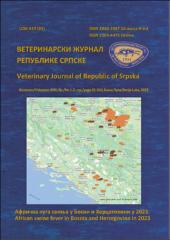| dc.description.abstract | The lameness is the earliest but also the most important clinical symptom of the
achropodium diseases in cattle. According to literary data, in 90% of cases, the
cause of lameness is localized in the hooves, and in 10% of cases it is in other
anatomical parts of the limb. In 88% of cases, the pathological process has been
manifested at the hind limb. Laminitis is an aseptic inflammation of the corium
of the hooves. In addition to the mechanical overloading of the hooves, the toxic
causes are also addressed as the causes of this disease. Longer feeding with
rapidly digested concentrate, rumen acidosis, sudden change of food components,
especially diet with green barley, oat, freshly harvested young legumes and
nutrition with molded food, can lead to laminitis. Laminitis is often the result of
impact of a large number of factors, such as metabolic and digestive disorders,
calving stress, mastitis, metritis, abomasal displacement, bedding without or with
very little straw, inability to move, obesity and poor diet. The ration that leads to
acidosis also leads to laminitis. Such a ration is difficult to correct in a case when the
carbohydrates are present in highest percentage. Vasoactive substances (histamine),
which enter the bloodstream from rumen, are considered to lead to damage of the
hoof corium. Metabolic disorder is caused by a low pH of rumen, which leads to
pathophysiological disorders, which eventually result in the ischemia of the hoof
corium and clinically manifest laminitis (leg disposal due to pain, and sometimes
forced lying). In addition to histamine and bacterial endotoxins, milk acids and other biologically active substances are believed to contribute to the onset of this
disease. The application of basic principles of the nutrition of the lactating cows
can prevent the appearance of laminitis and therefore the appearance of economic
losses due to lameness. | en_US |

